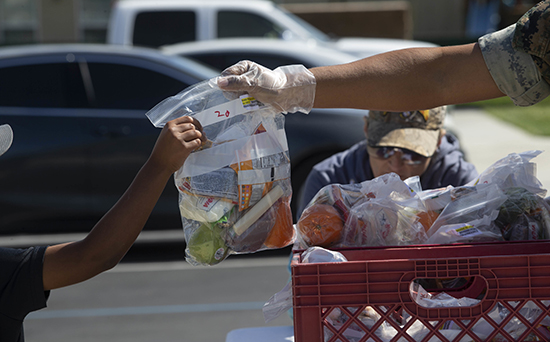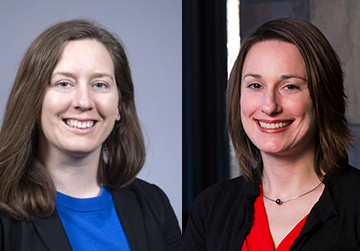Protecting the Health of Vulnerable Children During COVID-19
 |
|
A U.S. Marine hands a child a bagged lunch at Camp Pendleton, California. Ensuring that nutrition assistance and health services continue to be delivered are among the key action steps to mitigate the impact of the COVID-19 pandemic. (Photo by Lance Cpl. Andrew Cortez, U.S. Marine Corps)
|
ALBANY, N.Y. (June 25, 2020) – When coronavirus cases began accelerating in the United States in late February and early March, the rising pandemic prompted an unprecedented shutdown of K-12 schools throughout the country. The upheaval saw the closure of 124,000 schools at its height, impacting 55.1 million students.
Now, as schools, public health officials and government leaders chart a plan to safely reopen in the fall, UAlbany researchers Erika Martin and Lucy Sorensen are taking a look at the steps we need to take to protect the health and well-being of the most vulnerable children impacted by the pandemic.
 |
|
Rockefeller College of Public Affairs and Policy researchers Lucy Sorensen, left, and Erika Martin.
|
Publishing in JAMA Health Forum, Martin and Sorensen shed light on the disproportionate health impact of the closures on vulnerable children, and the steps that may be required to enable a successful return to the classroom in the fall.
“Without a vaccine, school closures were part of a comprehensive public health strategy to curb viral transmission, although their effectiveness is debatable,” said Martin, associate professor of public administration and policy at the Rockefeller College of Public Affairs and Policy. “As COVID-19 evidence evolves, there is increased awareness of the disproportionate health impact of closures on vulnerable children and an intensified call to reopen schools safely.”
These impacts include the health consequences of food insecurity, access to school-based health centers (SBHCs) and behavioral health resources, and access to special education resources.
“Health consequences of food insecurity, for instance, can include fatigue and reduced immune response which could in turn potentially increasing the risk of COVID-19,” said Sorensen, an assistant professor of public administration and policy at Rockefeller College.
Without access to school-based health centers or behavioral health resources, students face higher risks for substance abuse and depression. For those students who are quarantined, the situation is worse.
“Prolonged school closure and home confinement may cause social isolation, lengthened screen time, frustration and boredom, weight gain, and disrupted sleep cycles,” said Sorensen. “Children quarantined or in isolation during disease outbreaks have more post-traumatic stress symptoms than those not quarantined, and early findings suggest higher depressive symptoms among home-restricted students in Wuhan, China.”
According to the Kaiser Family Foundation, low-income US households have already experienced disproportionately higher behavioral health impacts from COVID-19. Meanwhile, the shutdown has also left as many as 40 percent of parents of special education students with no support whatsoever following school closures.
With so much at stake, Martin and Sorensen are offering eight action steps to help mitigate the adverse health consequences of the closures, and chart a path forward for when in-school learning returns:
- Ensure that schools continue to deliver nutrition assistance and health services. Many cities converted school buses to use for meal delivery or developed centralized pickup locations with multiday food packages. Strategies for SBHCs include communicating with families about how to access services, pivoting to telehealth models, coordinating with other health centers to ensure continuity of care, and developing protocols to reopen safely.
- Develop tutoring programs with virtual options. Tutoring can prevent learning loss and can particularly benefit families whose parents struggle with literacy. One potential model would be pairing college students (who may need be in need of summer jobs or internships) with K-12 students.
- Take a holistic cross-sector approach. School districts could partner with community organizations to provide for students’ varied health, social, and economic needs.
- Train school staff in trauma-based practices for working with students and families. Addressing students’ psychological and emotional trauma is necessary to facilitate learning, and there are existing crisis-response protocols, such as the National Association of School Psychologists’ PREPaRE curriculum.
- Use social media to engage students. Engaging students on video conferencing platforms is challenging. Teachers can use social media creatively to deliver instructional content, such as teaching math on TikTok. Fitness and other apps could benefit students who are missing after-school activities, such as team sports; this loss is particularly challenging for students who cannot afford summer sports programs or who lack safe outdoor environments for play.
- Foster an organizational culture of quality improvement. Schools will experience failures and successes as they deliver remote services this summer and implement protocols for safe returns in the fall. Implementing quality improvement tools, such as those developed by the Institute for Healthcare Improvement, can help schools adapt their approaches in real time to emerging needs and evidence.
- Leverage the COVID-19 pandemic as a call to action to bridge the digital divide permanently. As some schools distribute mobile devices or laptops, and paper-based work packets to rural students without internet or technology, the COVID-19 crisis is reinvigorating debates to treat wireless internet access as a necessary public utility and to develop and implement innovative technologies for cost-effective broadband wireless in rural areas.
- Enhance infrastructure to address physical health, behavioral health, and other social services targeting vulnerable students. On average, U.S. school systems have only one nurse per 1,151 students, one counselor per 491 students, and one psychologist per 1,400 students. Nearly 80 percent of adolescents who need mental health services do not receive them, with higher unmet need among Latinos and the uninsured. Addressing these behavioral health service gaps is critical to support students struggling with school closures and to enable successful returns to the classroom.
“Each recommended action requires creative problem-solving, cross-sector collaboration, community partnerships, and most importantly, resources,” said Martin. “And while healthcare funding may have increased, state education budgets are in crisis throughout the nation, with social support programs often the first to face cuts.”
For Martin and Sorensen, a large influx of federal aid targeting the most economically disadvantaged schools and districts may be what’s necessary to pave a path forward.
![]() For more news, subscribe to UAlbany's RSS headline feeds
For more news, subscribe to UAlbany's RSS headline feeds
A comprehensive public research university, the University at Albany-SUNY offers more than 120 undergraduate majors and minors and 125 master's, doctoral and graduate certificate programs. UAlbany is a leader among all New York State colleges and universities in such diverse fields as atmospheric and environmental sciences, business, education, public health,health sciences, criminal justice, emergency preparedness, engineering and applied sciences, informatics, public administration, social welfare and sociology, taught by an extensive roster of faculty experts. It also offers expanded academic and research opportunities for students through an affiliation with Albany Law School. With a curriculum enhanced by 600 study-abroad opportunities, UAlbany launches great careers.


